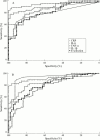Diagnosis of late onset neonatal sepsis with cytokines, adhesion molecule, and C-reactive protein in preterm very low birthweight infants
- PMID: 9462194
- PMCID: PMC1720722
- DOI: 10.1136/fn.77.3.f221
Diagnosis of late onset neonatal sepsis with cytokines, adhesion molecule, and C-reactive protein in preterm very low birthweight infants
Abstract
Aims: To evaluate the commonly used markers--namely IL-6, TNF alpha, IL-1 beta, C-reactive protein and E-selection for identification of late onset neonatal sepsis; to define the optimal cutoff value for each marker in preterm neonates; to assess whether these markers could assist in early discontinuation of antibiotics in non-infected cases; and to delineate the profile of these markers during systemic infection and in relation to successful treatment.
Methods: Very low birthweight infants in whom clinical sepsis was suspected when they were > 72 hours of age were eligible for study. A full sepsis screen was performed in each episode. Cytokines, C-reactive protein, and E-selectin were serially measured on days 0 (at the time of sepsis evaluation), 1, 2, 4 and 7. The optimal cutoff value for each marker was calculated after minimising the number of misclassified episodes over all possible cutoff values for days 0 and 1. The sensitivity, specificity, positive and negative predictive values for each test and combination of tests for predicting systemic infection were also determined.
Results: One hundred and one episodes of suspected clinical sepsis were investigated in 68 infants. Forty five episodes were proved to be infections. The optimal cutoff values were IL-6 31 pg/ml, TNF alpha 17 pg/ml, IL-1 beta 1 pg/ml, C reactive protein 12 mg/l and E-selectin 174 ng/ml. IL-6 had the highest sensitivity (89%) and negative predictive value (91%) for detecting late onset infection on day 0. However, between 24 and 48 hours of onset, C-reactive protein was the best single marker, with an overall sensitivity and specificity of 84% and 96%, respectively. The use of serial and multiple markers in the first 48 hours further enhanced the sensitivity and specificity of these tests. Performing IL-6 and C-reactive protein on day 0, together with either TNF alpha on day 1 or C-reactive protein on day 2, showed the best overall sensitivity (98%) and specificity (91%) for the diagnosis of late onset infection.
Conclusions: Optimal cutoff values for these markers in detecting late onset systemic infection in very low birthweight infants have been defined. Withholding antibiotic treatment at the onset of infection could be fatal and is not recommended, but the concomitant use of IL-6 and C-reactive protein or TNF alpha should allow antimicrobial treatment to be discontinued at 48 hours without waiting for microbiological results, provided that the infants are in good clinical condition.
Figures


References
Publication types
MeSH terms
Substances
LinkOut - more resources
Full Text Sources
Other Literature Sources
Medical
Research Materials
